NVIDIA Single Card, Multi-GPU: GeForce 7950 GX2
by Derek Wilson on June 5, 2006 12:00 PM EST- Posted in
- GPUs
One Card, or Two?
Our first look at the 7950 GX2 will be a direct comparison to its closest SLI relative: the 7900 GT SLI. The purpose of this investigation is to attempt to answer some questions about the how differences in this single-card/multi-GPU implementation affect performance relative to the two card approach. The 7950 GX2 employs faster core and slower memory clock speeds than the 7900 GT, but these differences should produce fairly consistent performance deltas. Each GPU on the 7950 GX2 has twice as much RAM as the 7900 GT cards, but in past investigations we haven't seen memory size make any difference at resolutions below 2048x1536. The attribute we are really interested in is the performance differences created by the onboard PCIe switch.
From our side by side comparison, we can only attribute a maximum of 7% performance gain to the increase core clock of the 7950 GX2 over the 7900 GT SLI. At the same time, with a 10% higher memory clock on the 7900 GT SLI, we should see better performance in memory bandwidth limited situations on the 7900 GT SLI. Under games and settings with a balanced compute and memory load, these differences should come out in the wash.
There are quite a few tests in which both the 7950 GX2 and the 7900 GT SLI configurations are CPU limited or perform very similarly, but at higher resolutions we do see some differentiation. Everything gets magnified at high resolution: shaders must be run on more pixels and memory is hit harder. We could see that performance is fairly similar at CPU limited resolutions, but as we push the limit up above 3 megapixels and enable AA, we do see an advantage in favor of the 7950 GX2. For example, Quake 4 at 2048x1536 with 4xAA shows an absolutely gigantic 32% performance advantage over 7900 GT SLI. This isn't the norm, but even BF2 indicates a 7950 GX2 advantage of 13% (which is more than simple clock speed advantage can account for). Even if we haven't seen it before, memory size could be contributing to this advantage, but it also seems likely that the onboard PCIe switch could be reducing the latency involved in sending the frame data from one GPU to another.
In order to test this theory, we went back and retested the 7950 GX2 with muti-GPU mode disabled. Thus, we are able to bring you a comparison of the performance scaling between 7900 GT and SLI and 7950 GX2 in single and multi-GPU mode. This should give us a better idea as to whether the performance advantage of the GX2 is due to memory size or the PCIe switch.
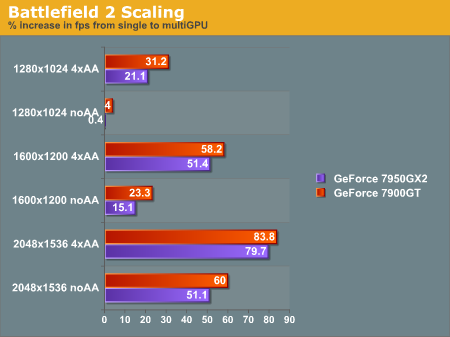
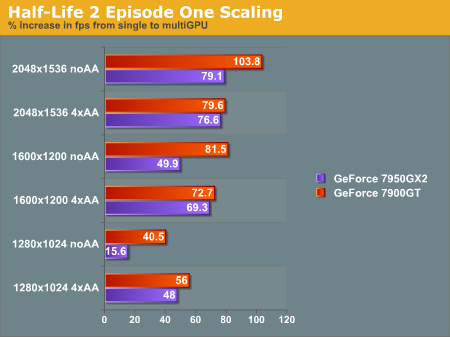
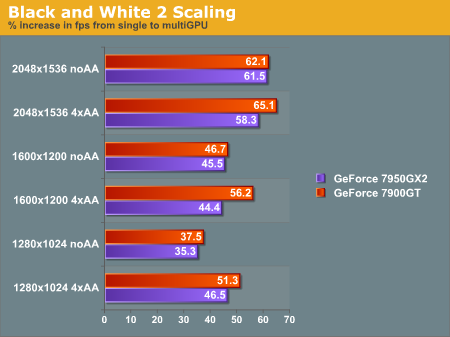
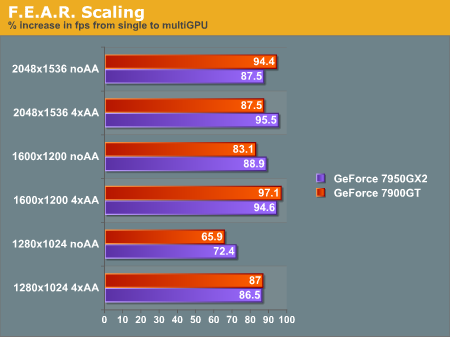
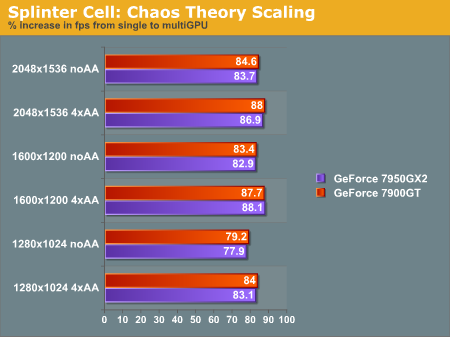
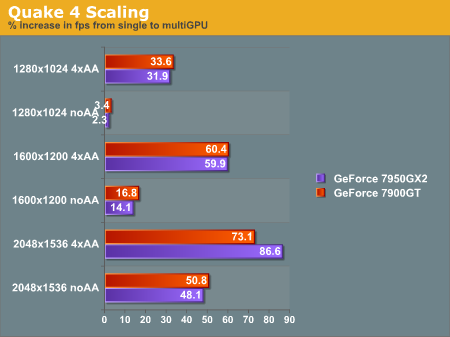
From the data we collected, it looks like the 7900 GT scales better at low resolutions in most cases. It doesn't look like there is a significant scaling advantage for the 7950 GX2 in any game but Quake 4 at 2048x1536 with 4xAA. At this point, we would say that Quake 4 appears to require more than 256MB of RAM when running HQ settings at 2048x1536 with 4xAA, resulting in the huge performance increase with 7950 GX2 over 7900 GT. In some cases, scaling does make a difference in where the performance falls between the 7950 GX2 and the 7900 GT SLI solutions, but it does look like the majority of the performance differences between the two solutions is due to clock speeds and other features which are constant between single and multi-GPU arrangements.
At the end of the day, regardless of how these two cards scale, the 7950 GX2 is consistently faster than a stock 7900 GT SLI setup. Even if there aren't any clear benefits in terms of efficiency on the 7950 GX2 platform, there aren't any drawbacks either. Let's take a closer look at performance.
Our first look at the 7950 GX2 will be a direct comparison to its closest SLI relative: the 7900 GT SLI. The purpose of this investigation is to attempt to answer some questions about the how differences in this single-card/multi-GPU implementation affect performance relative to the two card approach. The 7950 GX2 employs faster core and slower memory clock speeds than the 7900 GT, but these differences should produce fairly consistent performance deltas. Each GPU on the 7950 GX2 has twice as much RAM as the 7900 GT cards, but in past investigations we haven't seen memory size make any difference at resolutions below 2048x1536. The attribute we are really interested in is the performance differences created by the onboard PCIe switch.
From our side by side comparison, we can only attribute a maximum of 7% performance gain to the increase core clock of the 7950 GX2 over the 7900 GT SLI. At the same time, with a 10% higher memory clock on the 7900 GT SLI, we should see better performance in memory bandwidth limited situations on the 7900 GT SLI. Under games and settings with a balanced compute and memory load, these differences should come out in the wash.
There are quite a few tests in which both the 7950 GX2 and the 7900 GT SLI configurations are CPU limited or perform very similarly, but at higher resolutions we do see some differentiation. Everything gets magnified at high resolution: shaders must be run on more pixels and memory is hit harder. We could see that performance is fairly similar at CPU limited resolutions, but as we push the limit up above 3 megapixels and enable AA, we do see an advantage in favor of the 7950 GX2. For example, Quake 4 at 2048x1536 with 4xAA shows an absolutely gigantic 32% performance advantage over 7900 GT SLI. This isn't the norm, but even BF2 indicates a 7950 GX2 advantage of 13% (which is more than simple clock speed advantage can account for). Even if we haven't seen it before, memory size could be contributing to this advantage, but it also seems likely that the onboard PCIe switch could be reducing the latency involved in sending the frame data from one GPU to another.
In order to test this theory, we went back and retested the 7950 GX2 with muti-GPU mode disabled. Thus, we are able to bring you a comparison of the performance scaling between 7900 GT and SLI and 7950 GX2 in single and multi-GPU mode. This should give us a better idea as to whether the performance advantage of the GX2 is due to memory size or the PCIe switch.






From the data we collected, it looks like the 7900 GT scales better at low resolutions in most cases. It doesn't look like there is a significant scaling advantage for the 7950 GX2 in any game but Quake 4 at 2048x1536 with 4xAA. At this point, we would say that Quake 4 appears to require more than 256MB of RAM when running HQ settings at 2048x1536 with 4xAA, resulting in the huge performance increase with 7950 GX2 over 7900 GT. In some cases, scaling does make a difference in where the performance falls between the 7950 GX2 and the 7900 GT SLI solutions, but it does look like the majority of the performance differences between the two solutions is due to clock speeds and other features which are constant between single and multi-GPU arrangements.
At the end of the day, regardless of how these two cards scale, the 7950 GX2 is consistently faster than a stock 7900 GT SLI setup. Even if there aren't any clear benefits in terms of efficiency on the 7950 GX2 platform, there aren't any drawbacks either. Let's take a closer look at performance.










60 Comments
View All Comments
bluebob950 - Tuesday, June 27, 2006 - link
thinking about getting a 7950 but i cant find monitor any monitors that do 2048 my boss says the dell 21" at work do but i have yet to see it what do you use? and where can i find them online?bluebob950 - Tuesday, June 27, 2006 - link
thinking about getting a 7950gt but i cant find monitor any monitors that do 2048 my boss says the dell 21" at work do but i have yet to see it what do you use? and where can i find them online?JNo - Wednesday, June 7, 2006 - link
I think the review at Hexus.net bares a very interesting negative conclusion, somewhat in contrast to anandtech (not that I'm dissing anandtech), and provides food for sobering thought...http://lifestyle.hexus.net/content/item.php?item=5...">http://lifestyle.hexus.net/content/item.php?item=5...
Think seriously about what's been presented to you in this article thus far, concerning GeForce 7950 GX2, and you should (if I can do my job properly) come to a conclusion like this: NVIDIA GeForce 7950 GX2 is probably the most caveat-laden graphics purchase yet released.
The conditions that have to be satisfied before it makes sense to get one are pretty much as follows:
* Are you willing to live with less-than-absolute best image quality from the high-end generation right now?
* Are you sure the games you play all have SLI support, or you're at least happy to wait for support to come in a future driver?
* Do you have a PC platform that supports it properly, which is realistically just nForce SLI of some flavour?
* Do you have a very well ventilated PC chassis, able to assist in the significant cooling challenges it presents?
* Do you own a high resolution PC display, since it's built for at least 1600x1200 in current supported games?
* If you run dual displays, are you happy for one to go blank when in multi-GPU mode?
Be sure and really consider the first two questions, and ponder the fact that ATI Crossfire is arguably even worse at satisfying the second, given its lack of a user-adjustable game profiling system. Done so? Good.
Now given yes to all of the above, are you then willing to spend £450 on a single graphics board? You are? Brilliant, they're available today, you'll enjoy the framerates and overall IQ, happy shopping!
Tephlon - Wednesday, June 7, 2006 - link
I just wanted to point out... that list isn't just particular to this card. That's all SLI setups.All have to watch the heat. Drivers don't allow any SLI setup to dual-view+multi-GPU. SLI does dominate primarily in Hi-Res configs. and so on and so on.
Its still a great list to consider... but please remember that it isn't limited to just the 7950GX2.
DerekWilson - Wednesday, June 7, 2006 - link
except the 3rd point doesn't apply at all to 7950 GX2 -- It seems there has been a lot of confusion around the support requied for this card. It will run on Intel, ATI, VIA, SiS, an NVIDIA chipsets as long as the BIOS supports non-video devices in x16 PCIe slots along with supporting add-in PCIe switches. Suprisingly many boards support these features as of this week.the 7950 has a bunch of advantages over a 7900 GT SLI setup, not the least of which is performance. The lenient platform requirements, power draw less than an x1900xt, potential for expansion to quad sli, and it's really very transparently plug and play (just plug it in, install drivers, and no more tweaking is required for it to work as expected).
Jeff7181 - Tuesday, June 6, 2006 - link
On page three in the chart it says the 7900GTX core clock is 700 MHz (650 for vertex core). Is that accurate? So what I'm seeing and adjusting in the driver settings with coolbits is actually the speed of the vertex core?DerekWilson - Tuesday, June 6, 2006 - link
you know, I borrowed that chard from NVIDIA's reviewers guide on the 7950 GX2 ...I am under the impression that the vertex core of the 7900 GTX is 700MHz. As this is NVIDIA's chart, I'm not sure if vertex clock is listed first or second ...
Jeff7181 - Tuesday, June 6, 2006 - link
Based on the other values in the chart, and the row/column titles, I assumed the number given was supposed to be the core clock, and the one in parenthasis was supposed to be the vertex clock. I guess it could be a type-o... otherwise I want a new 7900GTX since the core speed of mine is only 650 MHz and it should be 700 according to that chart. :Dv12 - Tuesday, June 6, 2006 - link
Could you post comparative scores of the X1900XTX as well? does it beat the 7950 or not? I cant tell from this review.V12
AnnonymousCoward - Tuesday, June 6, 2006 - link
Thanks for the sweet article. 2 GPUs on a non-SLI board is the way to go...until dual-core GPUs. When are those coming out, anyway?